You can get lucky if you try to catch the last of the ski season. It’s a risk, of course, and you might end up with no snow atall, but if my visit to Gastein at the very tail end of the snow is anything to go by, you can get the best of all possible worlds. Of course, you had to go high to find it, but late season also means you’re also likely to be blessed with gorgeous weather throughout.
At the end of this season, there were more than enough snow-covered slopes on which to tire out my muscles. My guide, Helmut, not only drove me hard my first morning introducing me to all the runs on the upper slopes of the Schlossalm ski area, but when we paused briefly for a hot chocolate, he was also a mine of information about skiing throughout the Gastein valley.
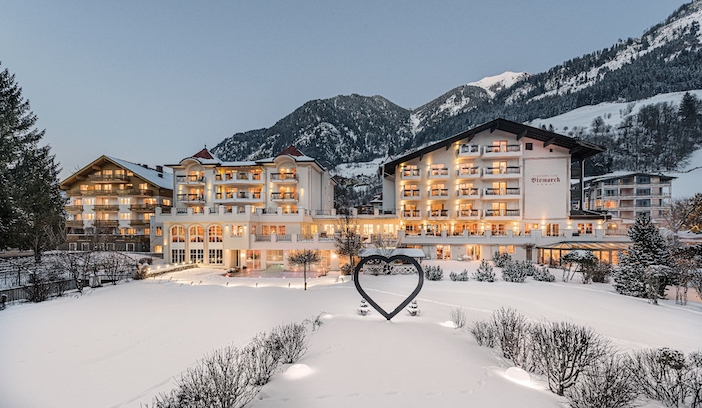
I was staying at the Hotel Bismarck at Bad Hofgastein. Otto von Bismarck, who stayed in Bad Gastein, may have beenknown as the ‘Iron Chancellor’ but there was nothing steely about the warm family atmosphere of the hotel. Indeed,given it was only a short walk from the main Schlossalm lift, the only potential obstacle in getting up the mountain early each morning was how long one allowed oneself to sit over breakfast provided by the friendly staff. And that’s beforewe get to the afternoon tea and cakes to entice weary skiers back down the mountain. There’s an excellent spa in the hotel, too, with an afternoon programme geared towards the needs of skiers, and I certainly took advantage of the saunas and the warm thermal pools.
The Gastein valley has three small towns, only a short bus ride apart, all with access to skiing. Dorfgastein is the first you encounter on entering the valley, the smallest and probably the least well known. Even so, it has some excellent skiing on the Kreuzkogel (2027m) with access to 20 different runs, including two Black runs, one ofwhich is off-piste. From the top of the Kreuzkogel you can also access the Grossarl ski area on the other side of the mountain and a further 19 runs. One advantage of skiing on the Kreuzkogel is that, even in bad weather, it never gets as windy as most of the Gastein slopes because it is on the opposite side of the valley and partially protected from the prevailing winds.
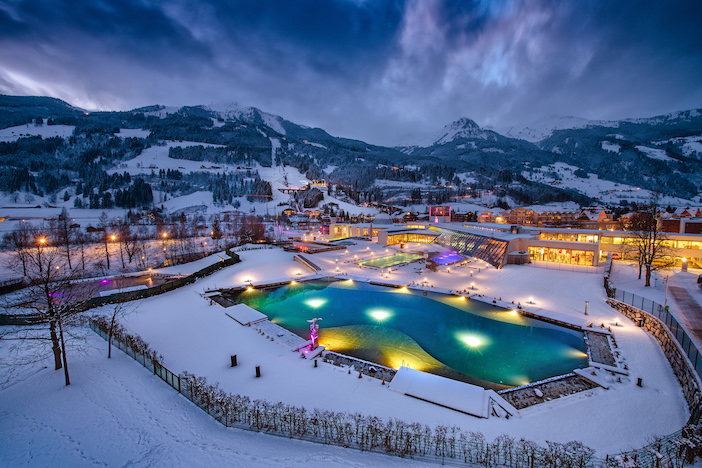
Bad Hofgastein, the next small town – more of a large village really – lies at the foot of the Mauskarspitz (2373m) and is home to the Alpentherme spa that uses the famous thermal waters of Bad Gastein. The Mauskarspitz and its neighbour,the Stubnerkogel (2251m) provide the largest interconnected ski area in the valley. Between them, and the Angartal area that links them, there is a web of 28 different runs for various abilities. The balance of the Mauskarspitz slopes is more family oriented – although it does feature the longest run in the valley, at 10.4 kilometres, and is the site of an annual race – whereas those on the Stubnerkogel provide more challenges for the adventurous as the slopes tend to be steeperand it is where the black runs are to be found.
The Schlossalmbahn gondola, the main lift system which provides comfortable and rapid access to the bowl-like upper slopes of the Mauskarspitz, first opened for the 2018-19 season. While the gondola nor the lifts go right to the actualsummit of the mountain, one chairlift does go to the Hohe Scharte col (2300m) just below the summit. This provides access to the start of some excellent red runs as well as access to the rear of the mountain and the ten-kilometre descent back to the valley.
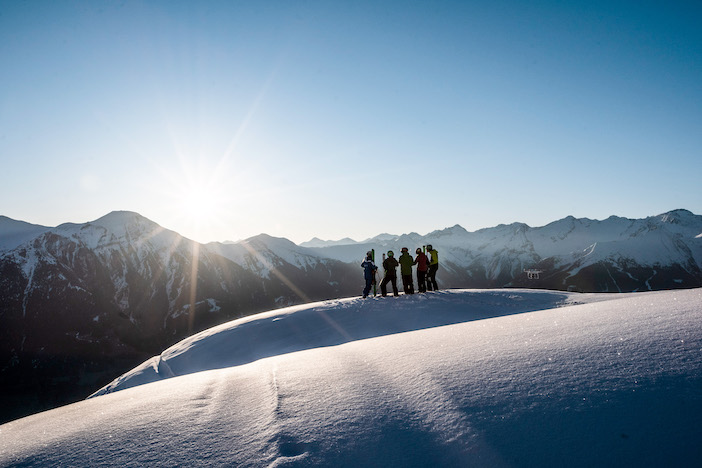
Helmut, my guide, did let on that a few adventurous souls will take their skis off and climb the seventy metres from the Hohe Scharte to the summit to ski down some of the summit couloirs when conditions are right. As for the ten-kilometre run you can break your descent at the gondola middle station and there is at least one hot chocolate stop once you are in the tree line. What sets this run apart is not just the length but the scenery.
Once you cross over the Hohe Scharte there is not a lift or a building to be seen anywhere until you are near the middle station, just snow-covered mountains in every direction. I was especially spoilt on my second descent as there were noother skiers in sight until we paused for a photo-stop and three people came past us. We saw no-one else until other runs linked into ours as we closed in on the gondola middle station. Sadly, given it was the last Saturday of the season there was not enough snow below the middle station to allow us to ski all the way down to the valley.
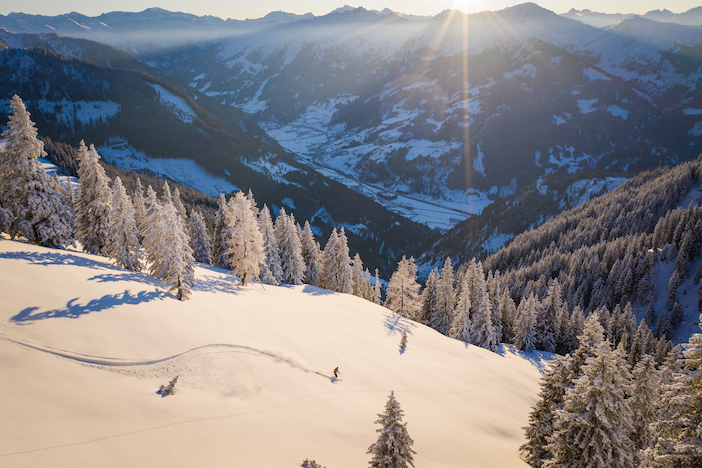
Bad Gastein is the third of the main settlements in the valley and provides access to two different and distinct ski areas.The town itself is very different to both Hof Gastein and Dorfgastein because of its history as a spa town frequented by royalty, the European aristocracy and the plain wealthy, especially during the 19th Century. As a result, it is full of Belle Epoque architecture and looks as though it had been transported to the Alps from Vienna or Budapest. The skiing on the Graukogel (2492m) was the first to be developed in the whole valley and even though there are only six graded runs – 2black, 3 red and one blue – it should not be overlooked. Because of its early development it is the only area without artificial snow with the result that even in very low temperatures it never gets as icy as elsewhere in the valley, and because the runs go through the treelines, visibility never gets quite as bad as elsewhere either.
The main ski area accessed via Bad Gastein is Sportgastein on the Kreuzkogel (2686m), the highest point not just in the valley but also in the whole of the Ski Amadé association area. Sportgastein provides the best skiing in the area for more advanced skiers with some 24 kilometres of runs altogether. The slopes are wide open, the sunniest in the whole valley, and the views spectacular. While the only drawback is that in bad weather the very openness of the slopes – they are allabove the tree line – means they tend to attract white-outs and fog, because of its altitude, the season usually lasts a week longer at Sportgastein than elsewhere in the valley.
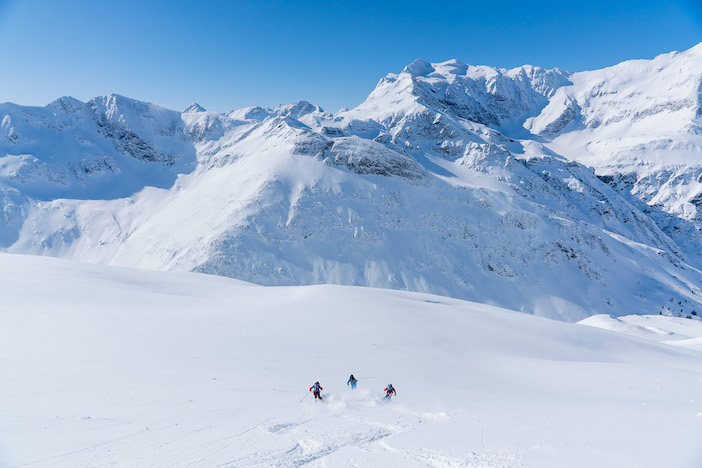
Skiing in the Gastein valley is suitable for all grades of skier and snowboarder. It is especially good for families and intermediate skiers. For more advanced skiers on a six-day trip my advice would be to spend two days warming up on the Schlossalm and the Mauskarspitz, two days on the Stubnerkogel and then two days really going for it on the Sportgastein slopes – weather and conditions permitting.
As for snow conditions, 2023-24 saw an excellent start to the season, a slightly warmer February than usual, followed by a March with an unusual and disruptive fohn wind which saw valley runs closing earlier than is normal and some very high winds late in the month. For my short visit early in April the weather was excellent and although you could no longer ski down to the valley the upper slopes were all sublime. In short, the Gastein valley offers something for everyone along with a warm and friendly welcome.
For more information about skiing in the Gastein, please visit www.gastein.com. Further information can be found at www.skiamade.com and www.salzburgerLand.com www.hotel-bismarck.com




